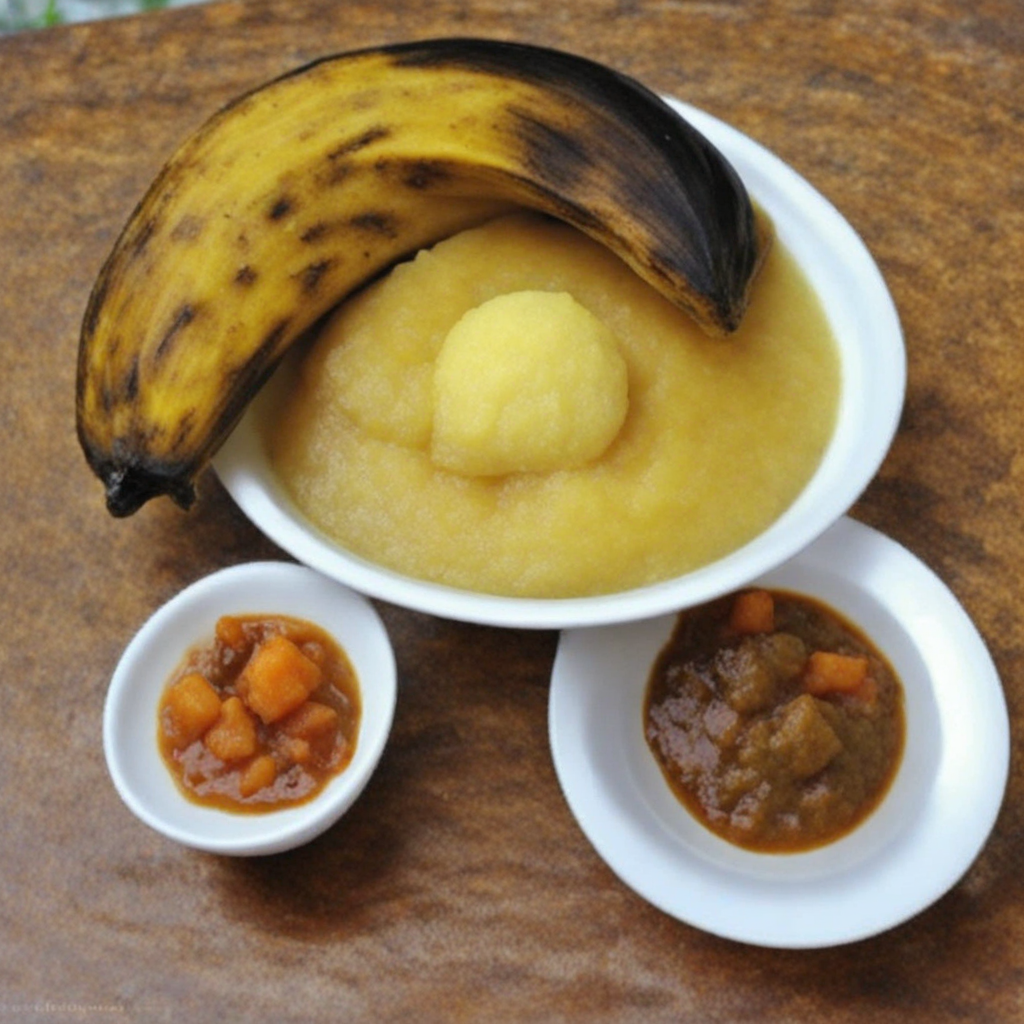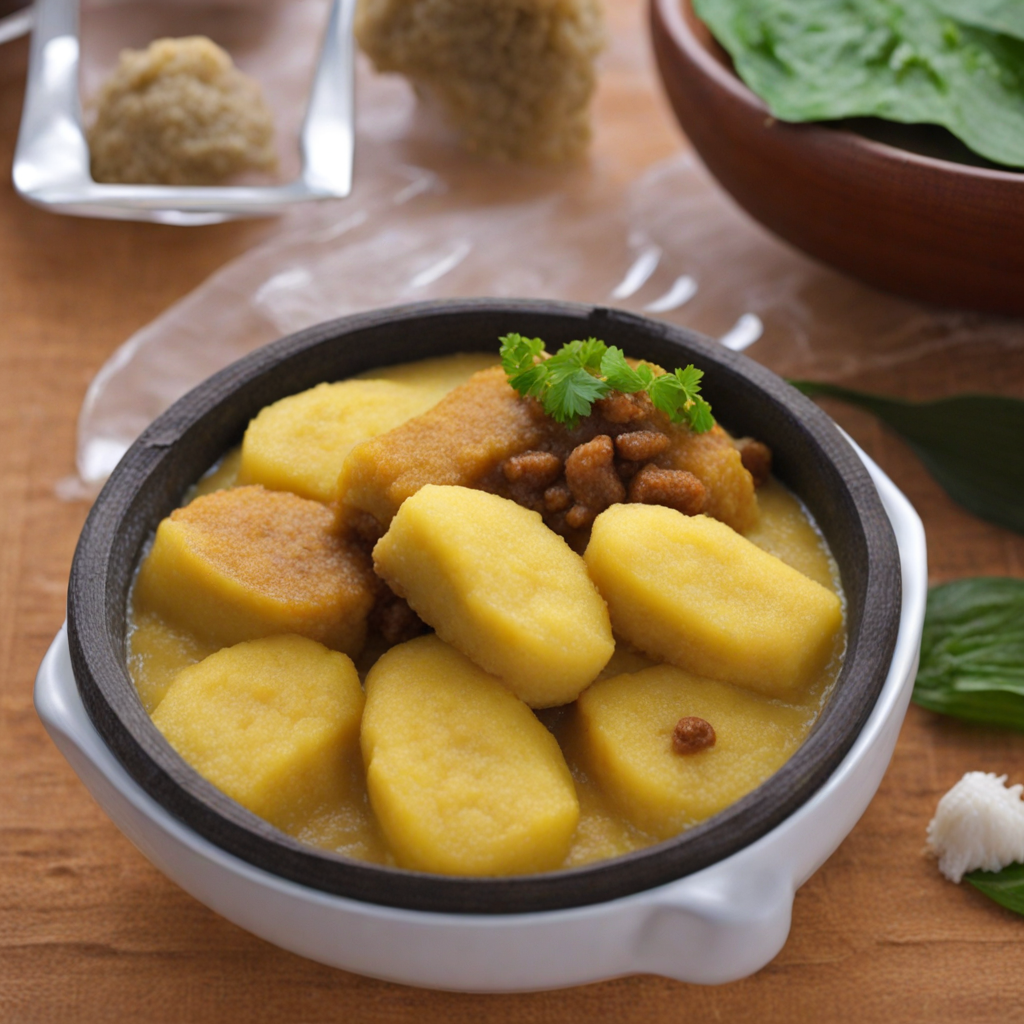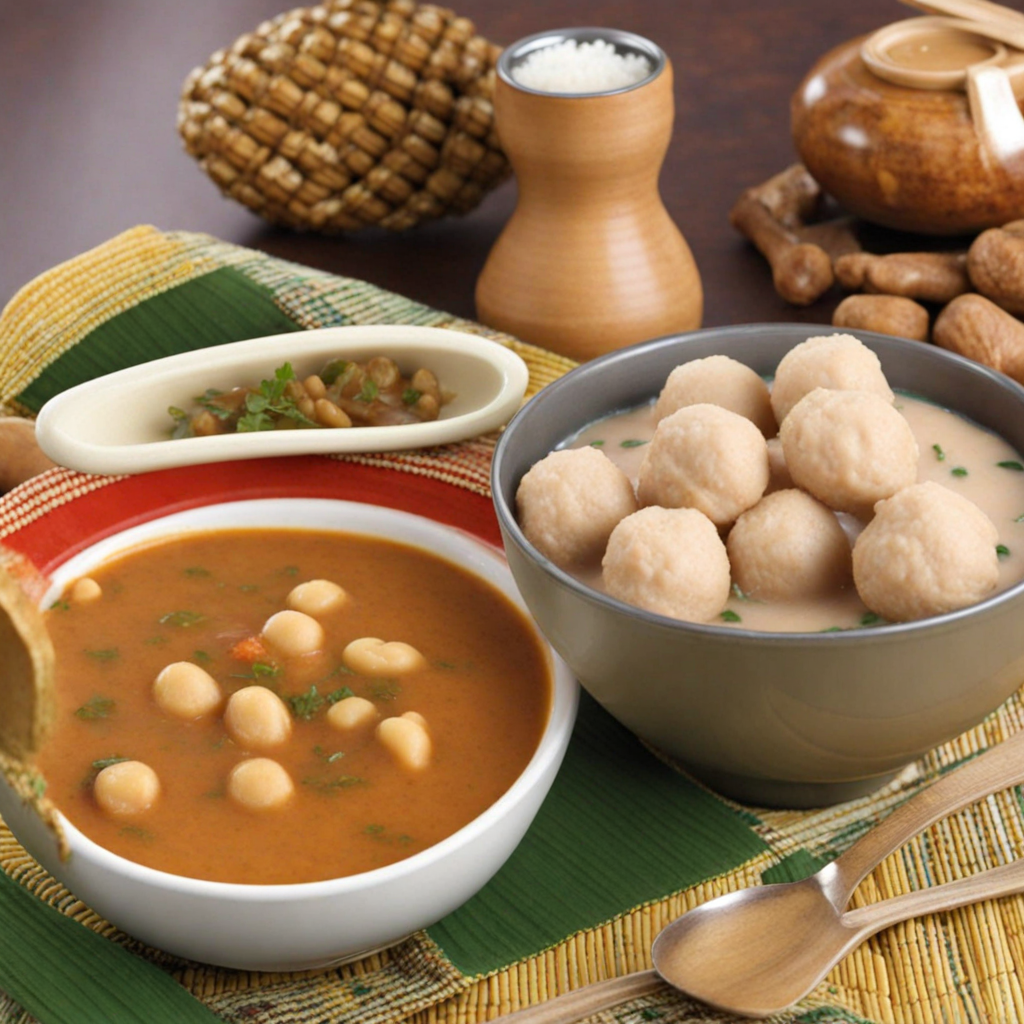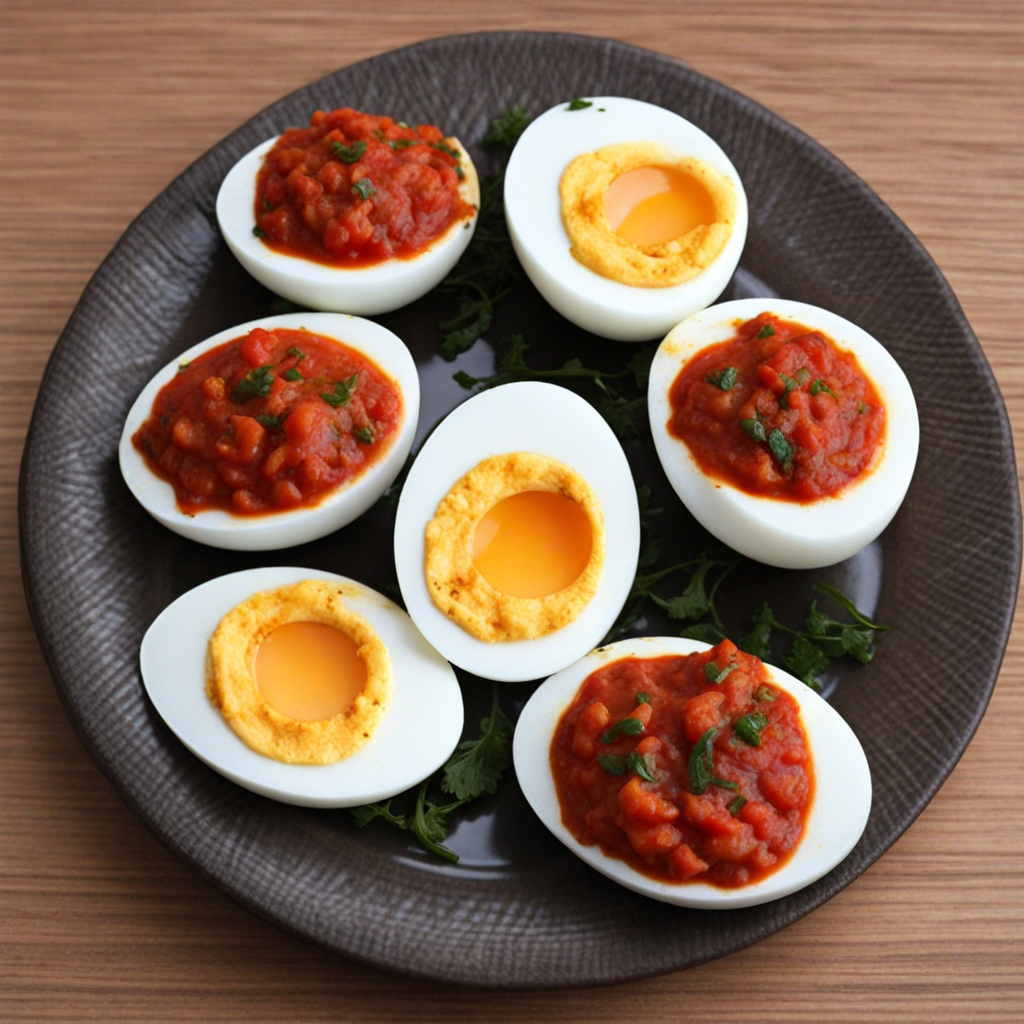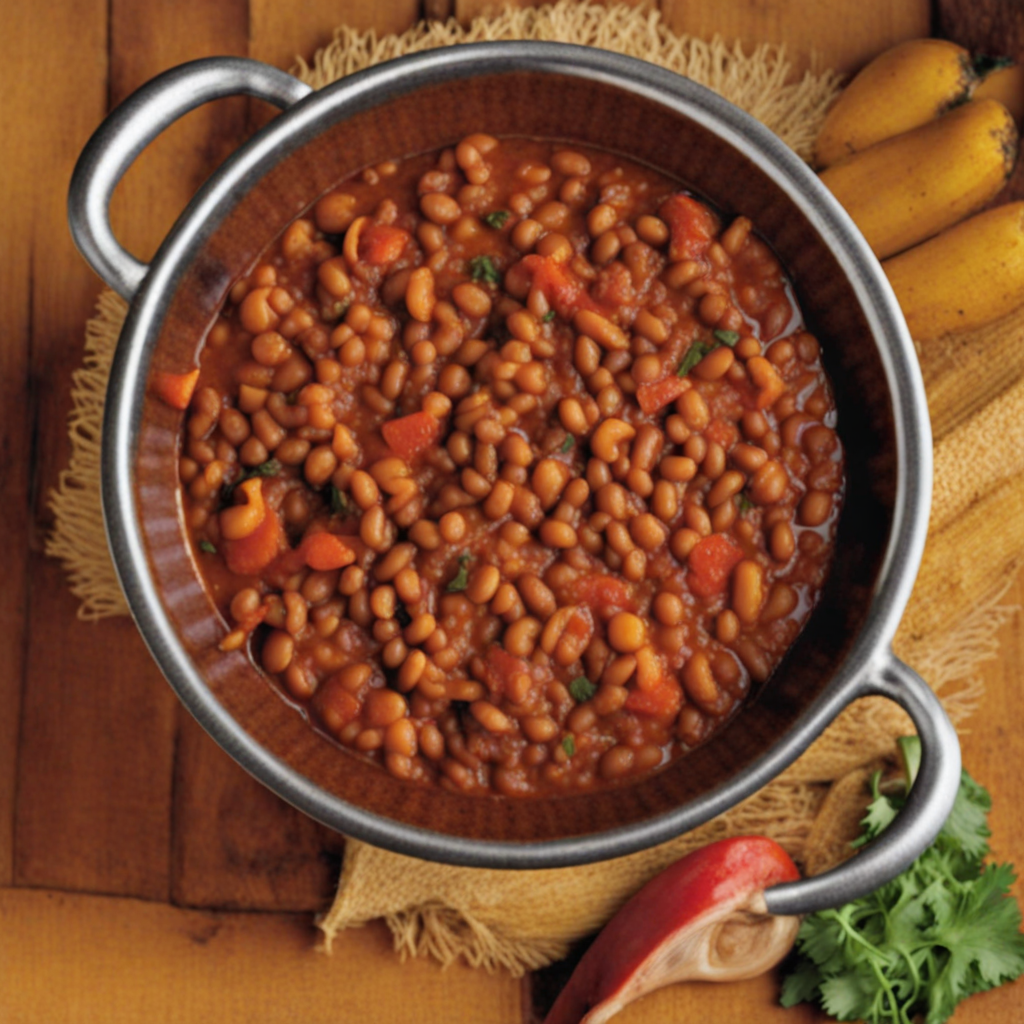Plantain Fufu
Plantain Fufu is a traditional Ghanaian dish that showcases the versatility of plantains, a staple ingredient in West African cuisine. This dish is made by boiling green plantains until they are tender, then mashing them into a smooth, stretchy paste. The process involves pounding the boiled plantains in a mortar and pestle, which gives the fufu its characteristic texture—soft yet slightly chewy. The flavor is mildly sweet with a subtle earthy undertone, making it a perfect accompaniment to a variety of rich soups and stews that are prevalent in Ghanaian cooking. What sets Plantain Fufu apart is its ability to absorb the flavors of the dishes it is served with. Typically, it is paired with hearty soups such as light soup, groundnut (peanut) soup, or palm nut soup, each bursting with spices and ingredients like meat, fish, and vegetables. The fufu serves not only as a side but also as a tool to scoop up the flavorful broth and ingredients, creating an interactive and satisfying dining experience. Its slight sweetness from the plantains beautifully complements the savory and spicy notes of the accompanying dishes. Eating Plantain Fufu is a cultural experience in itself. It is traditionally enjoyed with hands, where diners tear off a small portion of the fufu and use it to scoop up the soup or stew. This communal style of eating fosters a sense of connection and sharing among friends and family. Whether you're enjoying it at a local eatery or preparing it at home, Plantain Fufu offers a unique taste of Ghana, inviting you to explore the rich culinary heritage of the region through its delightful flavors and textures.
How It Became This Dish
Fufu: A Culinary Journey through Ghana Origins of Fufu Fufu, a staple dish in Ghana and across several West African countries, has a rich history that traces back centuries. Its roots can be found in the traditions of the Akan people, who inhabit the southern regions of Ghana. The word "fufu" is believed to derive from the Akan language, where it means "to mash" or "to pound." Traditionally, fufu is made by boiling starchy vegetables such as cassava, yams, or plantains and then pounding them into a smooth, elastic dough-like consistency. The process of making fufu is labor-intensive and often requires the use of a mortar and pestle—a tool that has been used for millennia. The origins of fufu can be linked to the agricultural practices of the Akan people and their cultivation of root vegetables. The dish is not just a food item; it represents a connection to the land, agricultural cycles, and the community's shared labor. While cassava, yams, and plantains are the most common ingredients, the specific type of fufu can vary based on regional availability and cultural preferences. Cultural Significance Fufu holds profound cultural significance in Ghanaian society. It is more than just a meal; it is an emblem of identity and community. The preparation of fufu is often a communal activity, where families come together to pound the ingredients, fostering social bonds and collective effort. The rhythmic pounding of the pestle against the mortar creates a sense of unity, echoing the values of cooperation and shared responsibility that are deeply rooted in Ghanaian culture. Fufu is typically served with a variety of soups and stews, such as light soup, groundnut soup, or palm nut soup, each reflecting the diverse culinary traditions of Ghana. The act of eating fufu is also culturally significant; it is customarily consumed with the fingers, allowing diners to appreciate the texture and flavor more intimately. This communal aspect of dining promotes a sense of belonging and reinforces familial and social ties. In addition to its social importance, fufu also plays a role in traditional ceremonies and celebrations. It is often served during significant events such as weddings, funerals, and festivals, symbolizing abundance and prosperity. In these contexts, sharing fufu with guests signifies hospitality and respect, reinforcing its status as a food of honor. Development Over Time The development of fufu over the years has been influenced by various factors, including globalization, urbanization, and technological advancements. Historically, the preparation of fufu required considerable physical labor, but with the advent of modern kitchen appliances, such as blenders and food processors, the process has become more accessible. While traditionalists may argue that this mechanization detracts from the authenticity and communal aspect of fufu preparation, it has undeniably made the dish easier to prepare for many families. Moreover, the globalization of food culture has led to the introduction of fufu in international cuisines, promoting its recognition beyond Ghana’s borders. In recent years, fufu has gained popularity in urban areas, both within Ghana and in the diaspora, as a result of increased migration and cultural exchange. Restaurants featuring West African cuisine have sprung up in various parts of the world, showcasing fufu alongside other traditional dishes. This has contributed to the growing appreciation of Ghanaian culinary heritage and has sparked interest in learning about the cultural narratives behind the food. The ingredients used to make fufu have also evolved over time. While cassava, yam, and plantains remain the primary components, other starchy vegetables and grains have been incorporated into fufu preparations. For instance, some variations now include the use of sweet potatoes, millet, or even rice, reflecting regional agricultural practices and preferences. Additionally, fufu can now be found in different forms, such as instant fufu flour—a product that allows for a quicker preparation time while still offering a taste reminiscent of traditional fufu. Fufu in Contemporary Ghana In contemporary Ghana, fufu remains a beloved dish, symbolizing both tradition and modernity. It is a staple in many households, enjoyed by people of all ages. Street vendors and restaurants serve fufu alongside an array of soups and stews, making it a convenient and affordable meal option for many. The dish has also found its way into popular media, with cooking shows and social media platforms showcasing the art of fufu preparation, further popularizing it among younger generations. Despite the changes and adaptations that fufu has undergone, the essence of the dish remains intact. It continues to represent the values of sharing, community, and cultural heritage. In the face of globalization and modernization, many Ghanaians strive to preserve the traditional methods of fufu preparation, ensuring that future generations remain connected to their roots. Conclusion Fufu is more than just a food item; it is a symbol of Ghanaian identity, a testament to cultural resilience, and a reflection of the communal spirit that defines the nation. From its ancient origins among the Akan people to its current status as a beloved staple, fufu has evolved while maintaining its significance in Ghanaian society. As people continue to gather around the mortar and pestle, the rhythmic sounds of fufu preparation will echo through generations, preserving the stories and traditions that have made this dish a cherished part of Ghanaian culture. In a world that is rapidly changing, fufu stands as a reminder of the importance of community, heritage, and the bonds that are forged over shared meals. As Ghanaians and food enthusiasts around the world celebrate this culinary treasure, the story of fufu remains an enduring narrative of identity, belonging, and the timeless joy of shared sustenance.
You may like
Discover local flavors from Ghana


